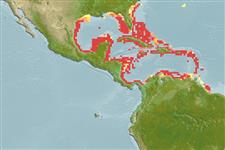Actinopterygii (ray-finned fishes) >
Perciformes (Perch-likes) >
Chaetodontidae (Butterflyfishes)
Etymology: Prognathodes: Greek, pro = first, in front of + Greek, gnathos = jaw (Ref. 45335).
Environment / Climate / Range
Ecology
Marine; reef-associated; non-migratory; depth range 1 - 100 m (Ref. 110583), usually 15 - 55 m (Ref. 110583). Tropical, preferred ?; 33°N - 9°S, 98°W - 57°W
Western Atlantic: southern Florida and the western Gulf of Mexico to the West Indies-Caribbean region and Venezuela.
Size / Weight / Age
Maturity: Lm ? range ? - ? cm
Max length : 10.0 cm TL male/unsexed; (Ref. 47838)
Dorsal
spines
(total): 13 - 14;
Dorsal
soft rays
(total): 18-19;
Anal
spines: 3;
Anal
soft rays: 14 - 16. Upper half of body yellow-orange, shading into blackish basally in dorsal fin; lower half of body white; orange bands on head and a narrow orange bar on caudal peduncle (Ref. 13442).
Inhabit deep coral-rich reefs and drop-offs (Ref. 47838). Feed on small invertebrates. Often seen nibbling on the tube feet of sea urchins or the tentacles of tubeworms (Ref. 9710). Unlike some chaetodonts it does not pick parasites from the bodies of other fishes (Ref. 5521). Solitary, sometimes in pairs (Ref. 47838). Seek refuge when approached (Ref. 47838). Oviparous (Ref. 205). Form pairs during breeding (Ref. 205).
Life cycle and mating behavior
Maturity | Reproduction | Spawning | Eggs | Fecundity | Larvae
Form pairs during breeding (Ref. 205).
Allen, G.R., R. Steene and M. Allen, 1998. A guide to angelfishes and butterflyfishes. Odyssey Publishing/Tropical Reef Research. 250 p. (Ref. 47838)
IUCN Red List Status (Ref. 115185)
CITES (Ref. 94142)
Not Evaluated
Threat to humans
Harmless
Human uses
Aquarium: commercial
More information
ReferencesAquacultureAquaculture profileStrainsGeneticsAllele frequenciesHeritabilityDiseasesProcessingMass conversion
Tools
Special reports
Download XML
Internet sources
